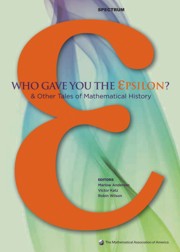Book contents
- Frontmatter
- Introduction
- Contents
- Analysis
- Foreword
- Who Gave You the Epsilon? Cauchy and the Origins of Rigorous Calculus
- Evolution of the Function Concept: A Brief Survey
- S. Kovalevsky: A Mathematical Lesson
- Highlights in the History of Spectral Theory
- Alan Turing and the Central Limit Theorem
- Why did George Green Write his Essay of 1828 on Electricity and Magnetism?
- Connectivity and Smoke-Rings: Green's Second Identity in its First Fifty Years
- The History of Stokes' Theorem
- The Mathematical Collaboration of M. L. Cartwright and J. E. Littlewood
- Dr. David Harold Blackwell, African American Pioneer
- Afterword
- Geometry, Topology and Foundations
- Algebra and Number Theory
- Surveys
- Index
- About the Editors
The Mathematical Collaboration of M. L. Cartwright and J. E. Littlewood
from Analysis
- Frontmatter
- Introduction
- Contents
- Analysis
- Foreword
- Who Gave You the Epsilon? Cauchy and the Origins of Rigorous Calculus
- Evolution of the Function Concept: A Brief Survey
- S. Kovalevsky: A Mathematical Lesson
- Highlights in the History of Spectral Theory
- Alan Turing and the Central Limit Theorem
- Why did George Green Write his Essay of 1828 on Electricity and Magnetism?
- Connectivity and Smoke-Rings: Green's Second Identity in its First Fifty Years
- The History of Stokes' Theorem
- The Mathematical Collaboration of M. L. Cartwright and J. E. Littlewood
- Dr. David Harold Blackwell, African American Pioneer
- Afterword
- Geometry, Topology and Foundations
- Algebra and Number Theory
- Surveys
- Index
- About the Editors
Summary
Balthasar van der Pol's experiments on electrical circuits during the 1920s and 1930s opened an interesting chapter in the history of dynamics. The need for advancements in radio technology made van der Pol's work pertinent and his research stimulated mathematical interest in non-linear oscillators. In particular, van der Pol's work caught the attention of Cambridge mathematicians M. L. Cartwright and J. E. Littlewood. Topology and Poincaré's transformation theory provided a key to analyzing behavior of non-linear oscillators and dissipative systems. Resulting mathematical techniques have played a significant role in the development of the modern theory of dynamical systems and chaos. In addition, non-linear oscillator theory has led to the development of radio, radar, and laser technology.
The collaboration between Cartwright and Littlewood began just before World War II and lasted approximately ten years. They published four joint papers, and individually published several other papers based on joint work. Their collaboration produced some of the earliest rigorous work in the field of large parameter theory. They were among the first mathematicians to recognize that topological and analytical methods could be combined to efficiently obtain results for various problems in differential equations, and their results helped inspire the construction of Smale's horseshoe diffeomorphism([28], pp. 63–80). Their names can be included with those mathematicians, including Levinson, Lefschetz, Minorsky, Liapounov, Kryloff, Bogolieuboff, Denjoy, Birkhoff, and Poincaré, whose work provided an impetus to the development of modern dynamical theory.
- Type
- Chapter
- Information
- Who Gave You the Epsilon?And Other Tales of Mathematical History, pp. 88 - 97Publisher: Mathematical Association of AmericaPrint publication year: 2009

